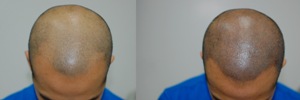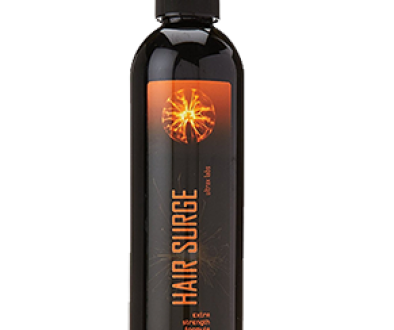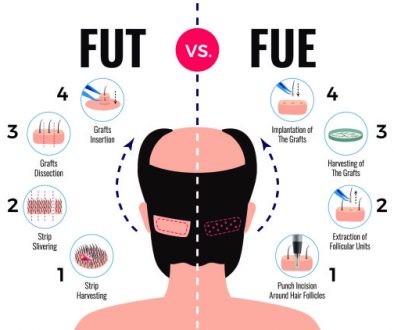Scalp Micropigmentation – A Viable Alternative to Hair Transplant Surgery?
 Scalp micropigmentation or SMP (the process of tattooing the scalp to promote an appearance of naturally growing hair) is becoming an increasingly popular procedure for balding men, especially those who’d like to maintain a closely cropped head of hair with an appearance of stubble. This intriguing procedure is frequently used to camouflage widening scars from previous hair transplant strip procedures. However, some hair transplant surgeons have begun utilizing this procedure to aid in thickening the appearance of naturally thinning hair. But is scalp micropigmentation for everyone? What are the benefits, limitations and practical usage of this procedure? Is scalp micropigmentation a viable alternative to hair transplant surgery?
Scalp micropigmentation or SMP (the process of tattooing the scalp to promote an appearance of naturally growing hair) is becoming an increasingly popular procedure for balding men, especially those who’d like to maintain a closely cropped head of hair with an appearance of stubble. This intriguing procedure is frequently used to camouflage widening scars from previous hair transplant strip procedures. However, some hair transplant surgeons have begun utilizing this procedure to aid in thickening the appearance of naturally thinning hair. But is scalp micropigmentation for everyone? What are the benefits, limitations and practical usage of this procedure? Is scalp micropigmentation a viable alternative to hair transplant surgery?
In a recent thread at our Hair Loss Discussion Forums, Coalition member Dr. William Rassman presented scalp micropigmentation results he’s working to perfect at his clinic. Several hair loss patients and hair restoration experts have shared their opinions. During this discussion, Coalition hair transplant surgeon Dr. Ron Shapiro shared his insights on the advantages, limitations, and practical usage of Scalp Micropigmentation. You can view his comments below.
I have been following the improvements in Scalp Micropigmentation over the last year, and I would like to share the limited experience I have had with this technique so far:
I was first exposed to this technique by a patient about a year ago. An old patient of mine had it done and came into my office. I had last seen him 17 years ago. He had been a repair case. At that time he wore a hair piece due to poor hair transplant at another clinic that left him with multiple scars in the donor area, a depleted donor area, and poor growth on top. He had very little donor left. 17 years ago we had very little options for him and what we decided was to do a hairline in front of his hair piece so at least the hair piece would look more natural. It worked well and I did not see him for the last 17 years
About a year ago he walked into my office without the hair piece, his head shaved, and with the micropigmentation. I was surprised at how it looked; much better than I had expected this to look. From about 3 feet it looked like a person had shaved his head and let it grow for about a week – like stubble.
It was very hard to see the scars. I did not like the look of the hairline … too abrupt. This type of hairline made sense in a young African American, but not an older Caucasian. In addition when I was closer than 3 feet I could tell there was something wrong because it had no depth. However, this patient liked this look. He was happy, and felt much better about himself.
Furthermore, I’ve had the same concerns that have been expressed before regarding the dye changing color, what happens when patient’s hair turns grey, what would happen if this was done on a younger person and then they lost additional hair, et cetera.
But I could also see the potential for how it could help at least a sub-population of hair transplant patients. This sub-population includes:
- Patients with donor scars that prevent them from cutting their hair short
- Patients who have undergone hair transplantation, but who still look thinner than they like. The reason for this could be one of many: poor donor supply, fine hair, poor growth, et cetera.
Over the last year I have sent 6 patients, who were in the above situations, to have the micropigmentation done. Because they were almost out of donor follicles, they had very few options and we felt comfortable trying the procedure.
My experience so far is that these patients are very happy with their early experience. It was especially good for hiding follicular unit transplantation scars, even with the hair short. It made them more comfortable, increased the appearance of density on the top of the scalp, and also blended nicely into the remaining hair.
In some cases the micropigmentation enabled me to extract a little more donor hair because the universal safe zone looked so much better and the new harvesting would be hidden. In addition I was careful to instruct the clinic doing the work to stay about 1 cm behind the hairline and fade away into it as I do not think it looks good at the hairline. I think this helped a lot.
Altogether, I think over time this technique has the potential to be a good adjunct used with surgical hair restoration.
However, we have to move slow and be careful, and I am glad there are physicians with a lot of experience in hair transplantation exploring the procedure.
Here are a summary of my thoughts and a few precautions I have at this time:
- I don’t think it is optimal as a primary treatment for a patient that is beginning to thin because he will be stuck with it after he continues losing hair and may not like the look (forcing a hair transplant procedure)
- I also do not currently like it as a primary treatment for a bald patient because I don’t think it creates as natural a hairline as possible.
- With respect to the ink fading – even if it faded in 4 years and they had to do it again, the patients I talked were ok with this compared to where they were before having to use dermatch daily. A bigger concern was that it would change color over time.
- With respect to color change – I don’t have a good feel for that at this time. Some of the patients I saw who had been out 2-3 years had a slight bluish or greyish tinge develop when I looked close, but surprisingly it did not affect the overall look and the patients were still happier than they were before the micropigmentation.
- I do think that it will be good for patients who have strip scars.
- I do think that it may enable us to get more hair out of the donor to use on the recipient area in some patients.
- I think if one does it on top that it should only be done after one has done hair transplants that have taken them 70 percent of where they want to go (this would be to improve the situation if they did not have enough donor to create greater density).
- I think people that do this need to stay away from the hairline and learn how to fade away as they get close (lowering density and lightening color).
- I think that it is difficult to learn how to make the micropigmentation strokes, so it stays as a discrete pinpoint dot that imitates a stubble of hair. there is a risk of it “bleeding” and coalescing which does not look good. This is dependent on the ink used, the needle used, the depth into the epidermis that the needle is inserted and probably other things. So until a good track record is developed by certain clinics I would say to be cautious.
Dr. Ron Shapiro
To participate and share your thoughts about Scalp Micropigmentation, feel free to visit the discussion topic “Scalp Micropigmentation“.
_______________
Blake – aka Future_HT_Doc
Editorial Assistant and Forum Co-Moderator for the Hair Transplant Network, the Hair Loss Learning Center, the Hair Loss Q&A Blog, and the Hair Restoration Forum
Follow our community on Twitter
Watch hair transplant videos on YouTube
Get Proven Hair Loss Treatments at the Best Prices by visiting our new Online Hair Loss Product Store
Technorati Tags: Scalp micropigmentation, SMP, hair transplant, hair transplant surgeons, Hair Loss, hair restoration, hair transplant patients, follicular unit transplantation scar, surgical hair restoration, hair transplantation, hair transplant procedure, strip scars



